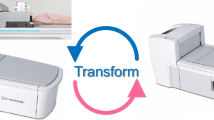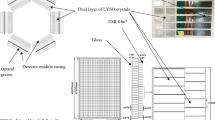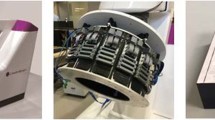Abstract
The SET-2400W is a newly designed whole-body PET scanner with a large axial field of view (20 cm). Its physical performance was investigated and evaluated. The scanner consists of four rings of 112 BGO detector units (22.8 mm in-plane × 50 mm axial × 30 mm depth). Each detector unit has a 6 (in-plane) × 8 (axial) matrix of BGO crystals coupled to two dual photomultiplier tubes. They are arranged in 32 rings giving 63 two-dimensional image planes. Sensitivity for a 20-cm cylindrical phantom was 6.1 kcps/kBq/m/ (224 kcps/μCi/ml) in the 2D clinical mode, and to 48.6 kcps/kBq/ ml (1.8 Mcps/μCi/ml) in the 3D mode after scatter correction. In-plane spatial resolution was 3.9 mm FWHM at the center of the field-of-view, and 4.4 mm FWHM tangentially, and 5.4 mm FWHM radially at 100 mm from the center. Average axial resolution was 4.5 mm FWHM at the center and 5.8 mm FWHM at a radial position 100 mm from the center. Average scatter fraction was 8% for the 2D mode and 40% for the 3D mode. The maximum count rate was 230 kcps in the 2D mode and 350 kcps in the 3D mode. Clinical images demonstrate the utility of an enlarged axial field-of-view scanner in brain study and whole-body PET imaging.
Similar content being viewed by others
References
Wienhard K, Eriksson L, Grootoonk S, Casey M, Pietrzyk U, Heiss W-D. Performance evaluation of the positron scanner ECAT EXACT.J Comput Assist Tomogr 16: 804–813, 1992.
Wienhard K, Dahlbom M, Eriksson L, Michel C, Bruckbauer T, Pietrzyk U, et al. The ECAT EXACT HR: Performance of a new high resolution positron scanner.J Comput Assist Tomogr 18: 110–118, 1994.
DeGrado TR, Turkington TG, Williams JJ, Stearns CW, Hoffman JM, Coleman RE. Performance characteristics of a whole-body PET scanner.J Nucl Med 35: 1398–1406, 1994.
Iida H, Miura S, Kanno I, Ogawa T, Uemura K. A new PET camera for noninvasive quantitation of physiological functional parametric images. Headtome-V-Dual.In Quantification of Brain Function Using PET. Myers R et al. (eds.), California, Academic Press, pp. 57–61, 1996.
Karp JS, Daube-Witherspoon ME, Hoffman EJ, Lewellen TK, Links JM, Wong W-H, et al. Performance standards in positron emission tomography.J Nucl Med 32: 2342–2350, 1991.
Colsher JG. Fully three-dimensional positron emission tomography.Phys Med Biol 25: 103–115, 1980
Defrise M, Townsend DW, Geissbuhler A. Implementation of three-dimensional image reconstruction for multi-ring tomographs.Phys Med Biol 35: 1361–1372, 1990.
Cherry SR, Dahlbom M, Hoffman EJ. 3D PET using a conventional multislice tomograph without septa.J Comp Assist Tomogr 15: 655–668, 1991.
Townsend DW, Geissbuhler A, Defrise M, Hoffman EJ, Spinks TR, Bailey DL, et al. Fully three-dimensional reconstruction for a PET camera with retractable septa.IEEE Trans Med Imag MI-10: 505–512, 1991.
Yamamoto S, Iida H, Miura S, Kanno I. Development of a 2-dimensional gamma ray position sensitive detector for PET.Radioisotopes 45: 229–235, 1996. (in Japanese)
Yamamoto S, Amano M, Miura S, Iida H, Kanno I. Deadtime correction method using random coincidence for PET.J Nucl Med 27: 1925–1928, 1986.
Iida H, Miura S, Kanno I, Murakami M, Takahashi K, Uemura K, et al. Design and evaluation of HEADTOME IV: a whole body positron emission tomograph.IEEE Trans Nucl Sci NS-36: 1006–1010, 1989.
Sashin D, Mintun MA. Development of scatter correction techniques for quantitative 3D imaging in a whole body PET scanner with the septa retracted.IEEE Conf Nucl Sci and Med Imag; 1332–1334, 1994.
Karp JS, Muehllehner G, Qu H, Yan XH. Singles transmission in volume-imaging PET with a137Cs source.Phys Med Biol 40: 929–944, 1995.
Meikle SR, Dahlbom M, Cherry SR. Attenuation correction using count-limited transmission data in positron emission tomography.J Nucl Med 34: 143–150, 1993.
Grootoonk S, Spinks TJ, Sashin D, Spyrou NM, Jones T. Correction for scatter in 3D brain PET using a dual energy window method.Phys Med Biol 41: 2757–2774, 1996.
Bailey DL, Meikle SR. A convolution-subtraction scatter correction method for 3D PET.Phys Med Biol 39: 412–424, 1994.
Author information
Authors and Affiliations
Corresponding author
Rights and permissions
About this article
Cite this article
Fujiwara, T., Watanuki, S., Yamamoto, S. et al. Performance evaluation of a large axial field-of-view PET scanner: SET-2400W. Ann Nucl Med 11, 307–313 (1997). https://doi.org/10.1007/BF03165298
Received:
Accepted:
Issue Date:
DOI: https://doi.org/10.1007/BF03165298




